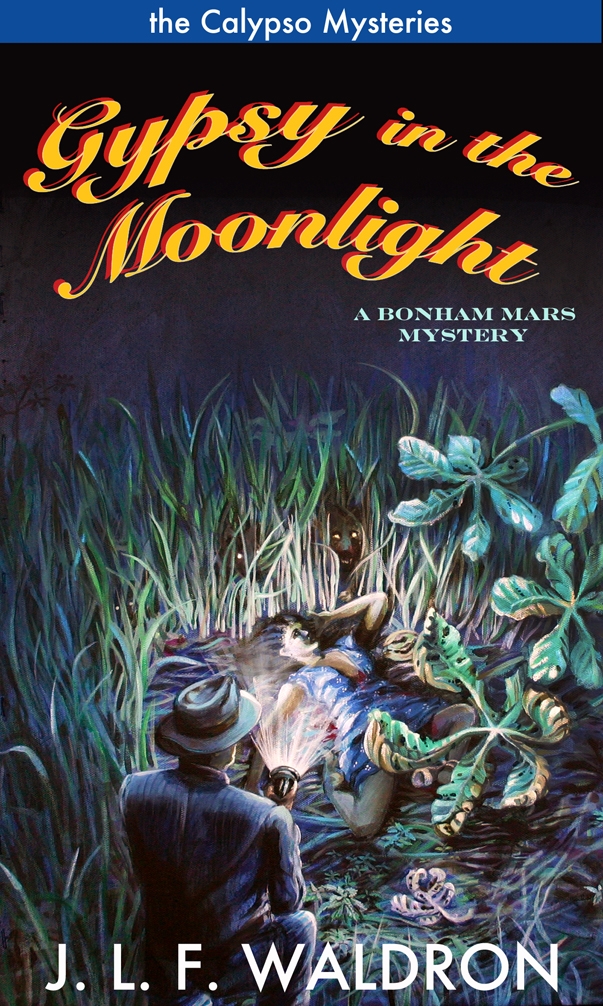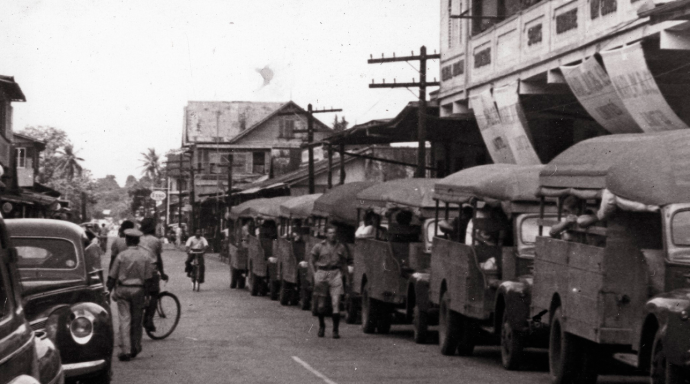|
Getting your Trinity Audio player ready...
|
Reading Time 4 mins
Within Rum and Coca Cola
By Duff Mitchell
 L. F. Waldron’s Gypsy in the Moonlight, with its appeal to thoughts and feelings, is a fine piece of literary work. The author presents a sequence of events in a gently gripping tide of narrative that makes the reader anxious to find out what’s next. The story unfolds around the conflict between a mother and daughter as well as between American sailors and the community exemplified in an ex-policeman.
L. F. Waldron’s Gypsy in the Moonlight, with its appeal to thoughts and feelings, is a fine piece of literary work. The author presents a sequence of events in a gently gripping tide of narrative that makes the reader anxious to find out what’s next. The story unfolds around the conflict between a mother and daughter as well as between American sailors and the community exemplified in an ex-policeman.
Gypsy accounts for the American occupation of Trinidad and Tobago, beginning in 1942 with sailors stationed in Trinidad during World War II, as part of America’s mission to prevent Germany from establishing a beachhead in Panama. The novel gets its title as it outlines the dramatic disturbance of colonials going through hard times then having to angrily settle for the cancellation of Carnival, while struggling with the debate on adult suffrage along with the upheaval over the right to collective bargaining of oil and sugar workers.

Tubal Uriah Butler and Dr Eric Williams
The central character is a fearless and well-rounded ex-policeman, Bonham Mars, who served time on Nelson Island for transgressions in the name of Uriah Butler. Mars is “salt fish”: the kind-a-guy whom Trini would recognize as ‘a man about town‘. He is ‘Trini to the bone’. He knows Tom, Dick and Harry… not to mention Peter, James and John … as well as Jean, Dinah, Rosita and Clementina. Yet, whenever the need arises he can employ important tactics copied from stick fighters. He lives in East Dry River on the doorsteps of the womb of the embryonic tamboo bamboo and the birth place of the steel pan, as well as, overlooking the St Ann’s River where Park and Picadilly streets meet at the eastern gateway to the centre of the city of Port of Spain. He revels in calypso. He engages in triumphant conflict with and over the best and the worst of what those days of the American presence offered to all walks of life of the people of Trinidad and Tobago. Moreover, Mars provides Waldron with the opportunity to employ his baton of delectable dialogue to conduct a pleasurable treat in a symphony of verbal and physical dramatics while describing Mars’ encounters with four special women in the plot.
I find it mind blowing that Waldron, a relatively young man, could immerse himself in history in the making–as I witnessed it while growing up in Belmont, Duke Street and in Laventille–and craft his fiction with almost flawless accuracy and consummate intuition. Indeed, Waldron’s panoramic encapsulation of the drama of life experience in a colonial Caribbean territory during the nineteen forties exposes him as the proverbial ‘man in the moon‘.

British and American servicemen in Port-of-Spain during World War II.
Gypsy beams light upon the dark days of the condescending presence of the Americans in particular and brightens the path from Atilla’s outcry against ”blue eyed babies to mind “ along with Lord Invader’s “Rum and Coca Cola” lament over the degrading socio-economic power of the Yankee Dollar and Lord Kitchiner’s “You can’t support me on calypso” leading through Mighty Terror’s “Brown skin gurl/ stay home and mind baby” to the exhaling leap, almost two decades later, that ushers The Mighty Sparrow’s front and center pronouncement over the plight of “Jean and Dinah”. In other words, Gypsy in the Moonlight invites our attention to a keenness of the mind’s eye gaining fodder for the calypsonian’s expression of derision even for Hitler’s mustache and disdain for Mussolini’s tyrannically wild aggression. In addition, in an extendedly lighter linguistic sense, this book pregnant as it is with our idioms and lingo, footnotes the Mighty Conqueror’s ditty contending that, “Webster shoulda come to Trinidad to complete he dictionary.” To state it simply: I have no doubt that Gypsy in the Moonlight ensures calypso its rightful place in world literature.
Waldron succeeds in sustaining our interest as he uncovers a gloomy period of our mid-twentieth century history by tapping into our sensory experiences with his employment of images of things heard, things smelled, things seen, things touched and things tasted.
!['March in the rain' to demand the return of Chaguaramas to the people of Trinidad and Tobago [1960].](https://www.bigdrumnation.com/wp-content/uploads/2016/04/EricBase.jpg)
March in the rain to demand the return of Chaguaramas to the people of Trinidad and Tobago [1960].
Mars sets out to find Bethany by getting a heads up from both Ms. Milly, boss of the clip joint named The Fig Leaf, and from Sgt. Mac Shain at police Head Quarters. Mars wends his way to seek out the voluptuous prostitute “Tess” at the Scarlet Ibis Club located in Yankee territory down Point Cumana. Incidentally, it is here he gets a surprising glimpse of the Ivy Nevins girl whose fate depicts itself on the cover of this book.
When Mars, now in darkness with an oily smelling bag over his bumpy head catches himself, he is prisoner discerning three distinct voices of the sailors getting the better of him in the roadside melee. He consequently determines to catch corbeau alive: “I must play dead in order to keep the hooligan sailors in the dark instead”. With almost unbelievable heroism Mars eventually returns home and gets rather much more than private attention in the ensuing days from (of all persons) his “Angel of Mercy”(an old firestick) Staff Nurse Dawn. As soon as he’s well enough, “after touching base wid de boys by de rum shop“, Mars is secretly back on the extremely significant trail that leads to the mountain side of the north coastal Maracas Valley.
At every turn of events in the plot, Waldron vividly stages the scene in which the action takes place with careful positioning of the characters in relation to the inanimate objects and often against the background of the prevailing weather conditions. His barking dogs are a symbol of trouble in the making while the tamboo bamboo drums excite the warm intensity of the development of the plot itself. Waldron skillfully takes us through the brew of complications surrounding relationships–real or imagined – whereas the narrative tapers off into the soliloquy of Mars’ voicing the surprising resolution of what appears to be a distillation of the idea that, according to James Breedie in his classical religious fiction titled Tobias and the Angel: “the fancies of a woman are bound by no law”.
 Duff Mitchell is a retired graduate teacher, writer and self-taught literary critic
Duff Mitchell is a retired graduate teacher, writer and self-taught literary critic.
